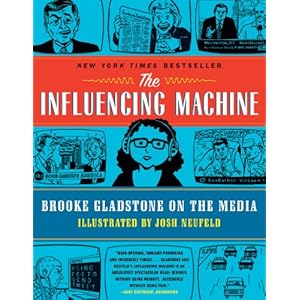The Influencing Machine is a work of graphic nonfiction, written by Brooke Gladstone of On The Media fame, and illustrated by Josh Neufeld, probably best known for a journalistic serial he drew about New Orleans after Hurricane Katrina. I first heard about it when Gladstone was interviewed on the Colbert Report in support of the book last year.  The interview was interesting and I’ve enjoyed On The Media, so when I happened to notice it at the Elliot Bay Book Company not long ago I picked up a copy. It was well worth the sticker price.
The interview was interesting and I’ve enjoyed On The Media, so when I happened to notice it at the Elliot Bay Book Company not long ago I picked up a copy. It was well worth the sticker price.
The goal of the book is to critically examine the nature of the American media, roughly beginning with the rise of print in the colonies. Its thesis is that there is no “Influencing Machine” if that phrase means to imply that the media are some kind of external, possibly sinister force that control or direct outcomes in public life. The media are instead a mirror, Gladstone argues: “We get the media we deserve.”
To support this, Gladstone and Neufeld take us through nearly 200 beautifully illustrated pages that examine the history of the media through specific examples as well as draw conclusions about how and why that history has played out the way it has. Particular attention is paid to the period of the founding and the great American wars since. Vietnam and Watergate, unsurprisingly, get particular scrutiny, and thankfully a great deal of attention is paid to contemporary state propaganda borne from 9/11 and the war on Terrorism.
But the book is not only an illustrated war history. Gladstone addresses topics in journalism theory like the illusive concept of objectivity and identifies a series of biases that are variously on display in any reporting: commericial bias predisposes news to be what sells, which is usually what’s new; bad news bias results in a disproportionate reporting about calamities, real and imagined; narrative bias causes reporting to be less about facts and more about what story the facts tell, at least in the mind of the teller; and so on. But none of this is a conspiracy; it’s simply a result of natural selection working on the universe of ideas.
The book concludes by looking to the future; past trends in media technology are deconstructed and extrapolated forward. Some time is even spent speculating about the singularity, the notion that we will one day become our machines and either achieve immortality or else be enslaved or dashed to bits by our new robot overlords. Throughout it all, Gladstone maintains that we and the media have essentially co-evolved, a notion which in my view isn’t surprising but is nevertheless thought-provoking and insightful.
The tone is fairly didactic but I don’t think it suffers for it. The illustration nicely complements the narrative, at times even constituting the greater part of it, and it remains engaging to the last. Gladstone says in the afterword that she knew she wanted to make a comic book before she knew it would be about journalism because she thought speech bubbles would be closer to radio. In this medium, Gladstone is our narrator and companion, and a great deal of her whimsical self is present in both style and content. At final reckoning, The Influencing Machine is a lovely and quick read I would encourage anyone to experience. I plan to leave my copy on the coffee table.
Published 2011, 170 pages.


